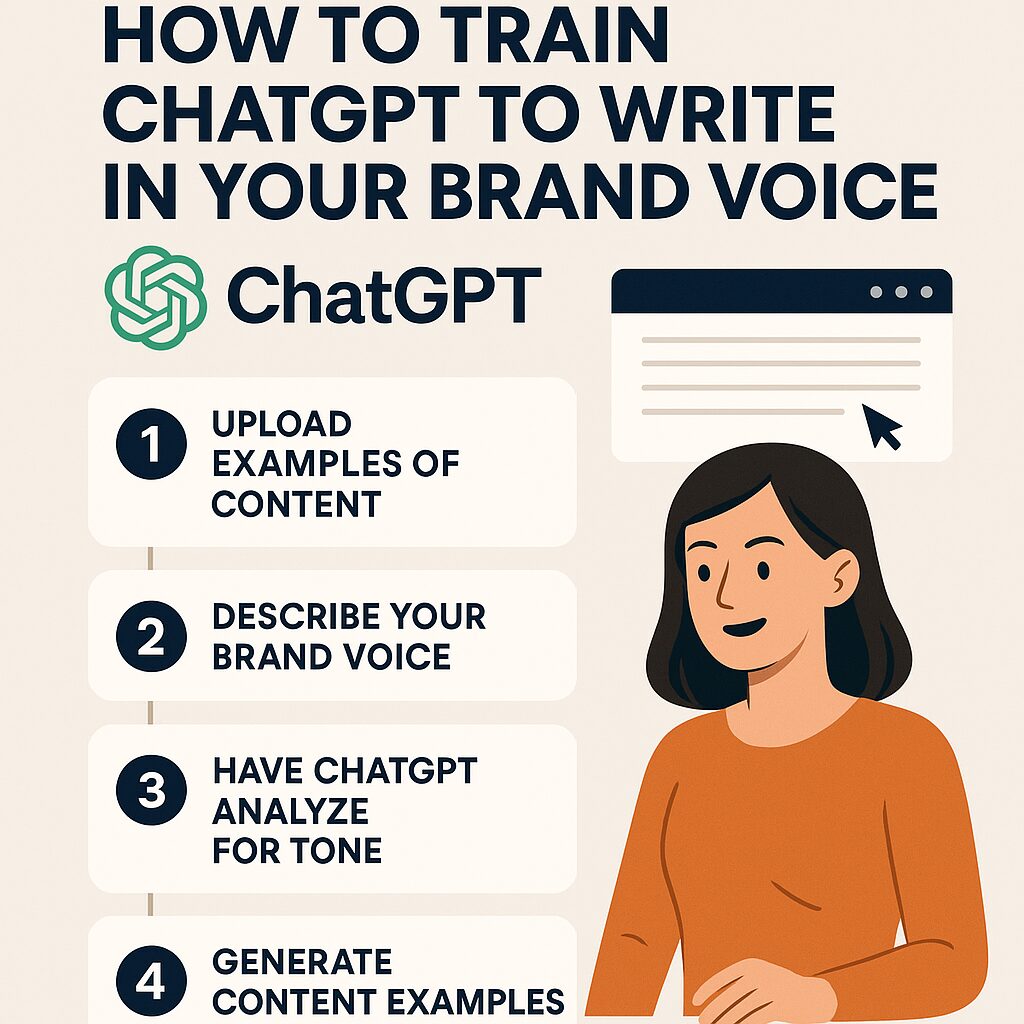
Whether you’re a solopreneur, content strategist, or business owner, one thing is clear: your brand voice matters. It’s how your audience connects with you, builds trust, and remembers your message.
But what happens when you’re producing content at scale—emails, blog posts, landing pages—and need help maintaining consistency across platforms? Enter ChatGPT, a powerful AI writing assistant that can be trained to sound just like you (or your brand).
In this guide, you’ll learn how to train ChatGPT to write in your brand voice—step-by-step—so you can boost your productivity without sacrificing authenticity.
What You’ll Need
Before you begin, gather the tools and materials you’ll need to train ChatGPT effectively:
-
ChatGPT Pro subscription (optional but recommended for access to GPT-4)
-
A collection of your brand’s existing content (blog posts, newsletters, social posts)
-
A documented brand voice guide (or samples that reflect your voice)
-
A text editor like Google Docs or Notion to organize inputs
-
Optional: Custom GPTs feature (available to ChatGPT Pro users for deeper training)
Step-by-Step Guide
Step 1: Define Your Brand Voice
Before training ChatGPT, get crystal clear on your brand tone and personality.
Ask yourself:
-
Is your brand voice formal or conversational?
-
Do you use humor, analogies, emojis, or stay buttoned-up?
-
What kind of phrasing, sentence structure, and vocabulary do you prefer?
Pro Tip: Use a simple voice chart to define your style:
| Trait | Description |
|---|---|
| Tone | Friendly, witty, bold |
| Language | Simple, jargon-free |
| Perspective | First-person singular |
| Rhythm | Short, punchy sentences |
Step 2: Gather Brand Voice Samples
To train ChatGPT, you need examples that reflect how your brand already communicates. Pull together:
-
3–5 blog posts
-
A few social media captions
-
Newsletters or email campaigns
-
Web copy or landing pages
Paste these into a doc and highlight phrases, sentence structures, or stylistic patterns that represent your tone.
Step 3: Craft a Brand Voice Prompt
Now that you’ve got your content, create a reusable prompt for ChatGPT. This is your brand’s “voice recipe.”
Here’s an example prompt:
“You are a copywriter writing on behalf of [Brand Name]. This brand has a friendly, energetic tone with a hint of sarcasm. They speak directly to the reader, use short punchy sentences, rhetorical questions, and occasional emojis. Write in the same tone, keeping it casual but authoritative.”
You can take it a step further by feeding ChatGPT a few content samples and asking it to summarize your voice:
“Here are three sample paragraphs from my brand. Analyze the writing style and summarize the tone, sentence structure, and vocabulary.”
Step 4: Test ChatGPT With Sample Content
Now you’re ready to generate content.
Try prompts like:
-
“Write a blog introduction on ‘5 Ways to Avoid Burnout’ using my brand voice.”
-
“Rewrite this product description in the same tone as the email below.”
Before/After Example:
Original GPT Output:
“Our software helps users manage their workload effectively.”
With Voice Training:
“Overwhelmed with work? Been there. Our tool’s like a personal assistant—minus the coffee breaks.”
See the difference?
Step 5: Refine, Iterate, Save
As with any AI tool, ChatGPT gets better with feedback. If something feels off:
-
Ask it to revise the tone: “Make this sound more playful”
-
Point out issues: “Avoid formal phrases like ‘therefore’—we don’t talk like that.”
Once you land on a version you love, save your prompt and ChatGPT’s output. This becomes a reference for future content or even a Custom GPT tailored to your brand (more on that below).
Pro Tips
-
Use ChatGPT’s memory: Enable memory so it remembers your preferences over time (available to Pro users).
-
Create a Custom GPT: If you’re a ChatGPT Pro user, build your own GPT that’s trained with your tone, values, and writing examples.
-
Layer instructions: Include tone, audience, goal, and format in your prompt for best results.
-
Name your voice: Giving your brand voice a persona (e.g., “Chill Millennial Mentor”) helps you and the AI stay consistent.
-
Avoid vague instructions: Don’t just say “make it fun”—say how it should be fun.
Pros and Cons of Using ChatGPT for Brand Voice
| Pros | Cons |
|---|---|
| Speeds up content creation | Requires manual editing for brand nuance |
| Adapts to detailed tone instructions | May default to generic tone if prompts lack detail |
| Easy to scale content with consistency | Needs strong input samples to learn properly |
| Supports creativity and brainstorming | Can occasionally misinterpret tone subtleties |
FAQs
1. Can ChatGPT really match my brand tone?
Yes, with clear prompts and quality samples, ChatGPT can mimic your voice quite closely. It won’t be perfect out of the gate, but with feedback and examples, it improves significantly.
2. Do I need a Pro subscription to do this?
No—but Pro users get access to GPT-4, which offers better reasoning and tone control. If your brand voice is nuanced or unique, the Pro version is worth the upgrade.
3. What’s the difference between a Custom GPT and regular prompts?
A Custom GPT lets you bake your brand voice and instructions into a reusable AI version that always writes like you. It’s perfect for teams or consistent content production.
Conclusion
Your brand voice is more than just a tone—it’s your personality on paper. With tools like ChatGPT, you can scale content creation without sacrificing authenticity. By training the AI with examples, clear prompts, and feedback, you can keep your messaging consistent across channels, no matter how fast you’re growing.
Whether you’re writing blogs, ads, or social captions, ChatGPT can be the perfect co-writer—you just have to teach it how you talk.
Ready to make ChatGPT sound just like you?
Start your journey today by signing up for ChatGPT Pro and creating a voice prompt tailored to your brand. Your content workflow just got a whole lot smoother.






